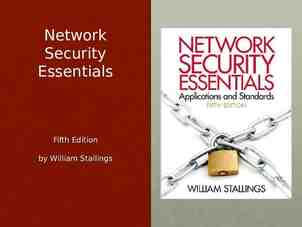G402: NIMS Overview for Senior Officials Douglas County Emergency
59 Slides4.98 MB
G402: NIMS Overview for Senior Officials Douglas County Emergency Management Robert Bieniecki and Jillian Rodrigue University of Kansas Emergency Management Andrew Foster and John Stipetich
Training Goals/Objectives Explore the senior/elected/appointed official’s role in emergencies Review the principles and elements of the National Incident Management System (NIMS) Explain the attributes and purpose of the Emergency Operations Center (EOC) Explain the attributes and purpose of the Joint Information System (JIS) and Joint Information Center (JIC)
NIMS/ICS Overview
What is an Incident? An incident is an occurrence, caused by either human or natural phenomena, that requires response actions to prevent or minimize loss of life, damage to property, and/or the environment.
NIMS What ? . . . NIMS provides a consistent nationwide template . . . Who? . . . to enable Federal, State, tribal, and local governments, the private sector, and nongovernmental organizations to work together . . . How? . . . to prepare for, prevent, respond to, recover from, and mitigate the effects of incidents regardless of cause, size, location, or complexity . . . Why? . . . in order to reduce the loss of life and property, and harm to the environment. 7
NIMS: What It Is/What It’s Not NIMS is . . . A flexible framework of: Doctrine Concepts Principles Terminology Organizational processes Applicable to all hazards and jurisdictions NIMS is not . . . An operational incident management plan A resource allocation plan A terrorism/WMD-specific plan Designed to address international events
Command vs. Coordination Command: The act of directing, ordering, or controlling by virtue of explicit statutory, regulatory, or delegated authority. Coordination: The process of providing support to the command structure, and may include incident prioritization, critical resource allocation, communications systems integration, and information exchange.
Incident Command System
What is ICS? The Incident Command System: Is a standardized, on-scene, all-hazards incident management concept. Allows its users to adopt an integrated organizational structure to match the complexities and demands of single or multiple incidents without being hindered by jurisdictional boundaries.
ICS Purposes Using management best practices, ICS helps to ensure: The safety of responders and others. The achievement of tactical objectives. The efficient use of resources.
ICS Benefits Meets the needs of incidents of any kind, size, or complexity. Allows personnel from a variety of agencies to meld rapidly into a common management structure. Provides logistical and administrative support to operational staff. Is cost effective by avoiding duplication of efforts.
ICS Organization Differs from the day-to-day, administrative organizational structures and positions. Unique ICS position titles and organizational structures are designed to avoid confusion during response. Rank may change during deployment. A “chief” may not hold that title when deployed under an ICS structure.
Command Staff The incident may designate Command Staff members who will: Provide information, liaison, and safety services for the Incident Command. Report directly to the Incident Commander.
Unified Command Established when no one jurisdiction, agency, or organization has primary authority and/or the resources to manage an incident on its own. Manages the incident by jointly approved objectives. Unified Command does not affect individual agency authority, responsibility, or accountability.
Senior Official’s Role in Incident Command Delegate authority for on-scene operations to IC/UC Provide policy guidance on priorities and objectives Activate specific legal authorities Oversee resource coordination and support to the Incident Command through the EOC
Delegation of Authority Delegation of authority may be in writing (established in advance) or verbal, and include: Legal authorities and restrictions. Financial authorities and restrictions. Reporting requirements. Demographic issues. Political implications. Agency or jurisdictional priorities. Plan for public information management. Process for communications. Plan for ongoing incident evaluation.
NIMS/ICS Management Characteristics 14 foundational characteristics of Incident Command and Coordination under NIMS: Common Terminology Management by Objectives Manageable Span of Control Comprehensive Resource Management Establishment and Transfer of Command Chain of Command and Unity of Command Dispatch/Deployment Modular Organization Incident Action Planning Incident Facilities and Locations Integrated Communications Unified Command Accountability Information and Intelligence Management
Common Terminology ICS requires the use of common terminology to define: Organizational functions. Incident facilities. Resource descriptions. Position titles. Use plain language and clear text, not codes.
Management by Objectives ICS is managed by objectives. Objectives are communicated throughout the entire ICS organization. Available resources must support incident objectives.
Incident Action Planning IC creates an Incident Action Plan (IAP) that: Specifies the incident objectives. States the activities to be completed. Covers a specified timeframe, called an operational period. May be oral or written—except for hazardous materials incidents, which require a written IAP. Takes into account legal and policy considerations and direction.
Modular Organization Develops in a top-down, modular fashion. Is based on the size and complexity of the incident. Is based on the hazard environment created by the incident. Incident objectives determine the organizational size. Only functions/positions that are necessary will be filled. Each element must have a person in charge.
Span of Control Span of control is the number of individuals or resources that a supervisor can manage effectively during an incident. Span of control is accomplished by organizing resources into teams, divisions, groups, branches, or sections. Incident personnel use their best judgment to determine effective span of control
Comprehensive Resource Management Resources include personnel, equipment, teams, supplies and facilities. Resource management includes processes for: Maintaining accurate, updated resource inventories. Resource activities to prepare for and respond to an incident. Reimbursement for resources used.
Integrated Communications Incident communications are facilitated through: Common communications plan. Interoperable communications processes and systems. Planning, to achieve integrated voice and data communications. Before an incident, it is critical to develop an integrated voice and data communications system (equipment, systems, and protocols).
Establishment and Transfer of Command The jurisdiction or organization with primary responsibility for the incident designates the individual at the scene responsible for establishing command and protocol for transferring command.
Chain of Command & Unity of Command Chain of command is an orderly line of authority within the ranks of the incident management organization. Unity of command means that every individual has a designated supervisor to whom he or she reports at the scene of the incident.
Dispatch/Deployment & Accountability At any incident, resources should: Deploy only when appropriate authorities request. Dispatch through established resource mgmt. systems. NOT spontaneously deploy if not requested by authorities. Be accountable, check in and out, use tracking systems.
Information and Intelligence Management The incident management organization establishes a process for gathering, analyzing, assessing, sharing, and managing incident-related information and intelligence. Process includes identifying EEI to ensure personnel gather the most accurate and appropriate data, translate it into useful information, and communicate it with appropriate personnel.
Break Please take 10 minutes for a break
Laws & Authorities 44 CFR 206.36 Requests for major disaster declarations Submission of request to President Basis for request Request shall include: Execution of State Emergency Plan Damage estimate Resources committed to disaster response PDA Certification by Governor Catastrophes of unusual severity and magnitude
Laws & Authorities KS Statutes and Administrative Regulations KSA Chapter 48-9xx: Emergency Preparedness For Disasters KSA Chapter 65-57: Emergency Planning And Community Right-To-Know KAR 56-2-2: Standards For Local Disaster Agencies
Laws & Authorities KS Statutes Annotated: Chapter 48-9XX Establishes KDEM/Defines TAG role (905a) Immunity to Liability (915) Governor’s role/declarations (924-5) State Plans, rules, & regulations (926) KDEM duties (928) Duties/authorities of counties (929) Kansas Mutual Aid System Compact (950-8)
Laws & Authorities KAR 56-2-2: Standards for Local Disaster Agencies Defines “local agency” and “coordinator” Establishes requirement for a local EM resolution or ordinance which: Gives authority to EM agency Defines the required EM functions Provides for required support to EM agency Defines the duties/qualifications of the coordinator
Local Resolutions Joint Cities-County Emergency Management Resolution (County Resolution 15-10) Establishes the Local Emergency Planning Committee; Provides for the authority and duties of the director of emergency management. National Incident Management System (NIMS) Resolution 06-40: Establishing NIMS as the incident system to be used for planning, preparing, responding, mitigating, and recovering from local emergency incidents.
Incident Coordination
Emergency Operations Center Physical location designed to support emergency response, business continuity and crisis communications. Collects, analyzes and shares information Supports resource needs and requests, including allocation and tracking Coordinates plans and determines current and future needs Provides public information Coordinates recovery operations In some cases, providing coordination and policy direction
EOC Benefits Helps establish a shared situation picture Simplifies information verification Facility long-term operations Increases continuity Provides ready access to all available information Aids resource identification and use
EOC and the Policy / MAC Group Local statutes or delegations may limit an EOC’s functions or actions Example: Monetary spending thresholds Policy / MAC Group may: Authorize additional fiscal resources Provide operational guidance Oversee complex incidents Provide operational or policy guidance
The Policy / MAC Group Provides policy guidance Supports resource prioritization and allocation Enables decision-making among elected and appointed officials and senior executives Is often compromised of: Elected Officials Senior decision-makers Senior public safety officials High-level, subject matter experts
Senior Official / Policy / MAC Group Actions Delegate appropriate authority to the EOC Director/Manager, EOC and JIS Issue an Initial Policy Statement to the EOC Determine reporting requirements for EOC, IC/UC and JIC/PIO Determine the Policy / MAC Group decision-making process and membership Identify fiscal issues and possible parameters for the EOC Define strategic level priorities for the incident Define the mission and strategic direction Identify operational priorities Provide policy guidance to the EOC, IC, & JIC Resolve scare resource allocation issues
Operational Priorities Policy/MAC Groups apply priorities at the policy level: Life safety Protect property and the environment Stabilize the incident Provide for basic human needs Restore essential utilities and program functions Coordinate among appropriate stakeholders Represent political, financial and legal concerns
Joint Information System (JIS) On-scene Public Information Impacted Organizations Schools Hospitals Long Term Care Facilities Red Cross Businesses/Industry Elected Officials (Public Expectation)
Joint Information System A system that provides the mechanism to organize, integrate, and coordinate information to ensure timely, accurate, accessible, and consistent messaging across multiple jurisdictions and/or disciplines with nongovernmental organizations and the private sector. Includes plans, procedures, and protocols to provide information to the public. Various Public Information Officers sharing and coordinating information prior to issuing a statement.
Managing Public Information The Public Information Officer (PIO): Manages media and public inquiries May have separate PIOs for EOC, Incident Command, Policy / MAC Group PIOs coordinate and disseminate incident information through the JIC Critical emergency information Crisis communications Public affair functions
Joint Information Center (JIC) A location where personnel with public information responsibilities perform critical emergency information functions, crisis communications, and public affairs functions. Enhances information coordination. Reduces misinformation. Maximizes resources.
Review of Senior Official’s Role In most jurisdictions, the Senior Official is responsible for: Ensuing the safety of the citizens and protection of property Ensuring the continuity of government Activating specific legal authorizes (disaster declarations, evacuations, state of emergency or other protective measures) Delegating authority for Incident Command to an IC/UC Coordinating with the PIO to keep media and public informed Requesting assistance from State agencies through the EOC Resolving resource allocation conflicts Coordinating with other senior officials and whole community partners Participating in the MAC Group/Policy Group
Exercise / Review
Exercise Incident A traffic accident in the City of Lawrence, involving a tanker truck, causes a large release of chlorine gas into the surrounding area. First responders are on scene and have requested activation of the EOC.
Exercise Assumptions Current projections have the plume reaching your location and will require you to shelterin-place until the area is deemed safe. The accident is happening now and is expected to last several hours (at last 8 hours).
Exercise Based upon your position: What policy decisions can only you make? With whom would you be communicating? Based upon what you’ve learned today, what critical services/assistance can you provide? What additional training would be helpful for you moving forward?
Additional Resources ICS courses are available online through the Emergency Management Institute. Participate in Emergency Management training and exercises. Review overall plans, authorities and policies related to emergency response.
Thank you! Questions?
Abbreviations: National Incident Management System (NIMS) Incident Command System (ICS) Emergency Operations Center (EOC) Joint Information Center / System (JIC/JIS) Local Emergency Operations Plan (LEOP) Emergency Management (EM) Kansas Division of Emergency Management (KDEM) Federal Emergency Management Agency (FEMA) Local Emergency Planning Committee (LEPC) Department Operations Center (DOC) Multiagency Coordination System/Group (MACS/MAC)
































































